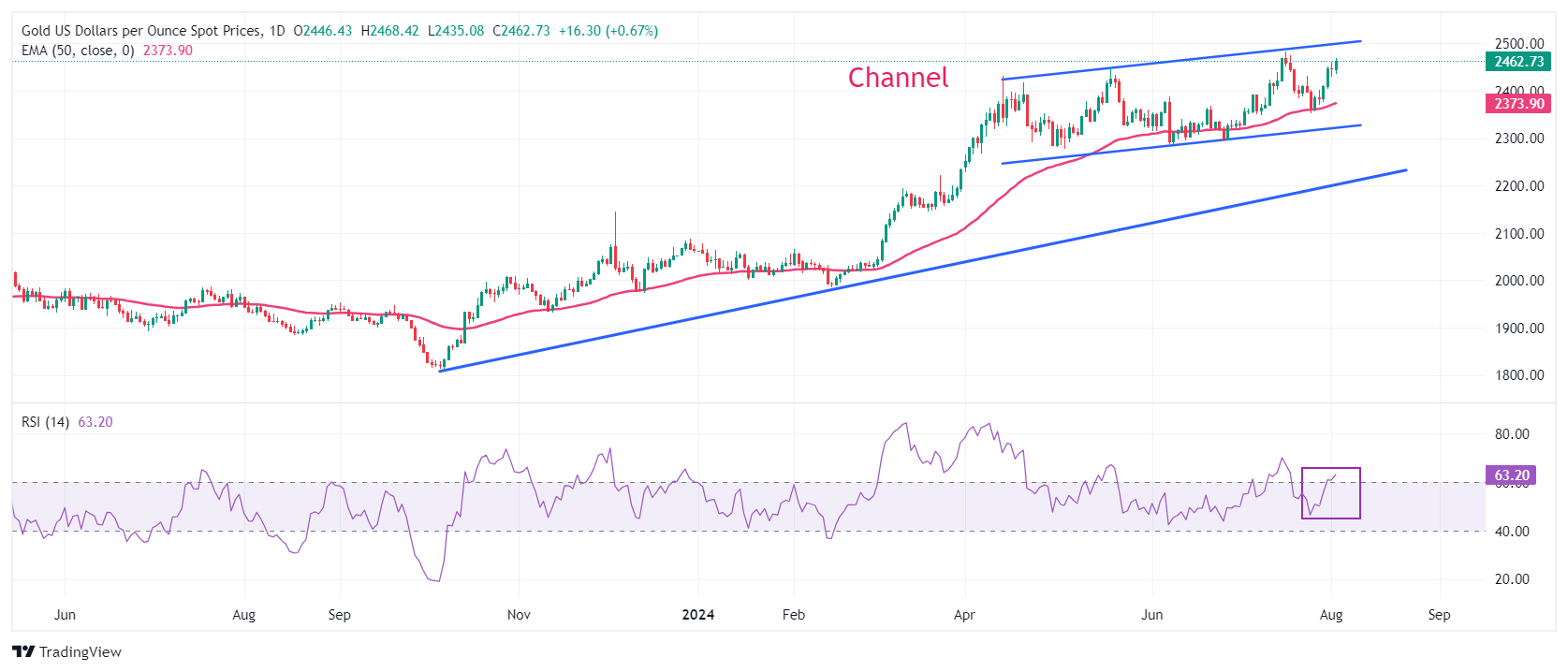Gold price jumps above $2,470 as US yileds plunge after weak US NFP
- Gold price climbs above $2,460 as US bond yields and the US Dollar dive after downbeat US NFP for July.
- The Fed appears comfortable with market speculation for interest rate cuts in September.
- Higher jobless claims and lower Unit Labor Costs point to a slowdown in US labor demand.
Gold price (XAU/USD) rises further above $2,470 in Friday’s American session. The precious metal rallies as US bond yields nosedive after the United States (US) Nonfarm Payrolls (NFP ) report for July, published by the Bureau of Labor Statistics (BLS), suggested that the labor market conditions have cooled down significantly. 10-year US Treasury yields plummet to more than six-month low near 3.82%.
Lower yields on interest-bearing assets reduce the opportunity cost of holding an investment in non-yielding assets, such as Gold. Meanwhile, the US Dollar Index (DXY), which tracks the Greenback’s value against six major currencies, plunges and posts a fresh four-month low to near 103.30.
The report showed that fresh payrolls came in lower at 114K than estimates of 175K and the former release of 179K, downwardly revised from 206K. The Unemployment Rate rose sharply to 4.3% from expectations and the prior release of 4.1%.
Meanwhile, Average Hourly Earnings data, a key measure of wage growth that fuels consumer spending and eventually drives price pressures, grew at a slower pace in July.. Annually, the wage growth measure decelerated to 3.6% from the estimates of 3.7% and the prior reading of 3.8%, downwardly revised from 3.9%. On month-on-month Average Hourly Earnings rose at a slower pace of 0.2% from expectations and the former reading of 0.3%. Softer-than-expected wage growth data will diminish fears of persistent inflation, which will strengthen Federal Reserve (Fed) rate-cut prospects.
Daily digest market movers: Gold price soars on weak US NFP, escalated geopolitical tensions
- Gold price jumps above $2,470 in Friday’s New York session session. The precious metal aims to recapture all-time highs above $2,480 as market speculation for the Fed to begin reducing interest rates in September appears to be certain amid deteriorating labor market conditions.
- The expectations for the Fed to pivot to policy normalization in September were already prompted after Fed Chair Jerome Powell delivered a dovish guidance on interest rates. On Wednesday, the Fed left interest rates steady in the range of 5.25%-5.50% but said that rate cuts would be on the table in September if inflation declines more or less in line with expectations, growth remains reasonably strong, and the labor market remains consistent with current conditions.
- Also, weak United States (US) ISM Manufacturing Purchasing Managers’ Index (PMI) for July, the highest Initial Jobless Claims in 11 months for the week ending July 26, and lower preliminary Q2 Unit Labor Costs have spurted upside risks to a slowdown in the economy and labor demand.
- The PMI report showed that activity in the manufacturing sector contracted at a faster pace to 46.8. Individuals claiming jobless benefits for the first time were higher at 249K than estimates of 236K and the former release of 235K. Unit Labor Costs, a key measure of total cost borne by employers for onboarding workers, grew at a very slower pace of 0.9% from expectations of 1.8% and the prior release of 3.8%.
- Meanwhile, deepening risks of an all-out war between Iran and Israel have improved the Gold’s safe-haven appeal. Iran vows to retaliate against the killing of Hamas leader Ismail Haniyeh by an Israeli air strike in Tehran.
US Dollar Price Today:
US Dollar PRICE Today
The table below shows the percentage change of US Dollar (USD) against listed major currencies today. US Dollar was the strongest against the Canadian Dollar.
| USD | EUR | GBP | JPY | CAD | AUD | NZD | CHF | |
|---|---|---|---|---|---|---|---|---|
| USD | -1.12% | -0.73% | -1.60% | -0.26% | -0.51% | -0.54% | -1.38% | |
| EUR | 1.12% | 0.38% | -0.50% | 0.85% | 0.61% | 0.58% | -0.27% | |
| GBP | 0.73% | -0.38% | -0.89% | 0.48% | 0.22% | 0.21% | -0.64% | |
| JPY | 1.60% | 0.50% | 0.89% | 1.38% | 1.11% | 1.07% | 0.24% | |
| CAD | 0.26% | -0.85% | -0.48% | -1.38% | -0.25% | -0.23% | -1.11% | |
| AUD | 0.51% | -0.61% | -0.22% | -1.11% | 0.25% | -0.01% | -0.87% | |
| NZD | 0.54% | -0.58% | -0.21% | -1.07% | 0.23% | 0.01% | -0.82% | |
| CHF | 1.38% | 0.27% | 0.64% | -0.24% | 1.11% | 0.87% | 0.82% |
The heat map shows percentage changes of major currencies against each other. The base currency is picked from the left column, while the quote currency is picked from the top row. For example, if you pick the US Dollar from the left column and move along the horizontal line to the Japanese Yen, the percentage change displayed in the box will represent USD (base)/JPY (quote).
Technical Analysis: Gold price climbs above $2,470
 `
`
Gold price trades in a channel pattern on a daily timeframe, which is slightly rising but broadly exhibited a sideways performance for more than three months. The 50-day Exponential Moving Average (EMA) near $2,370 continues to provide support to the Gold price bulls.
The 14-day Relative Strength Index (RSI) moves higher to near 60.00. If the RSI climbs above that level, the momentum will shift to the upside.
A fresh upside would appear if the Gold price breaks above its all-time high of $2,483.75, which will send it into unchartered territory.
On the downside, the upward-sloping trendline at $2,225, plotted from the October 6 low near $1,810.50, will be a major support in the longer term.
Nonfarm Payrolls FAQs
Nonfarm Payrolls (NFP) are part of the US Bureau of Labor Statistics monthly jobs report. The Nonfarm Payrolls component specifically measures the change in the number of people employed in the US during the previous month, excluding the farming industry.
The Nonfarm Payrolls figure can influence the decisions of the Federal Reserve by providing a measure of how successfully the Fed is meeting its mandate of fostering full employment and 2% inflation. A relatively high NFP figure means more people are in employment, earning more money and therefore probably spending more. A relatively low Nonfarm Payrolls’ result, on the either hand, could mean people are struggling to find work. The Fed will typically raise interest rates to combat high inflation triggered by low unemployment, and lower them to stimulate a stagnant labor market.
Nonfarm Payrolls generally have a positive correlation with the US Dollar. This means when payrolls’ figures come out higher-than-expected the USD tends to rally and vice versa when they are lower. NFPs influence the US Dollar by virtue of their impact on inflation, monetary policy expectations and interest rates. A higher NFP usually means the Federal Reserve will be more tight in its monetary policy, supporting the USD.
Nonfarm Payrolls are generally negatively-correlated with the price of Gold. This means a higher-than-expected payrolls’ figure will have a depressing effect on the Gold price and vice versa. Higher NFP generally has a positive effect on the value of the USD, and like most major commodities Gold is priced in US Dollars. If the USD gains in value, therefore, it requires less Dollars to buy an ounce of Gold. Also, higher interest rates (typically helped higher NFPs) also lessen the attractiveness of Gold as an investment compared to staying in cash, where the money will at least earn interest.
Nonfarm Payrolls is only one component within a bigger jobs report and it can be overshadowed by the other components. At times, when NFP come out higher-than-forecast, but the Average Weekly Earnings is lower than expected, the market has ignored the potentially inflationary effect of the headline result and interpreted the fall in earnings as deflationary. The Participation Rate and the Average Weekly Hours components can also influence the market reaction, but only in seldom events like the “Great Resignation” or the Global Financial Crisis.
Forex News
Keep up with the financial markets, know what's happening and what is affecting the markets with our latest market updates. Analyze market movers, trends and build your trading strategies accordingly.
